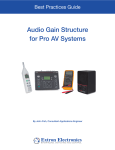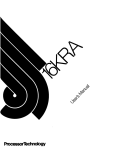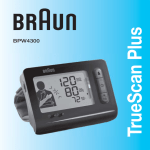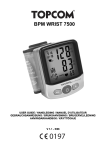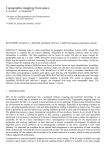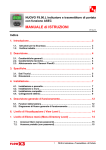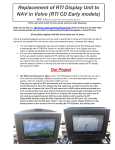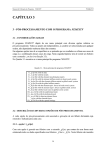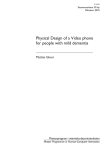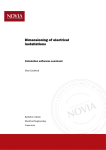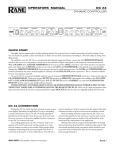Download BANG, A SYSTEM FOR SURVEYING THE
Transcript
Bachelor thesis
BANG
Benjamin Donald Oakes
2011/07/05
Bachelor thesis, 15 higher education credits, C-level
BANG,
A SYSTEM FOR SURVEYING THE
SEPARATION POINTS OF CARGO
GRENADES
Benjamin Donald Oakes
Audio engineering programme , 180 higher education credits
Örebro, spring term 2011
Examiner: Dag Stranneby
Örebro universitet
Akademin för naturvetenskap och teknik
701 82 Örebro
Örebro University
School of Science and Technology
SE-701 82 Örebro, Sweden
Bachelor thesis
BANG
Benjamin Donald Oakes
2011/07/05
Summary
This report describes the theory of the surveying system BANG which is used to determine the
position and time point of one to two separations of cargo grenades. From the time differences of
microphone registrations and microphone positions, the sought coordinates and time points of a
separation can be determined.
The major aim of the current project was to recode an earlier version of the software program written
in FORTRAN 77 to a modern high level language. This report describes the theory and calculations
made by the new program BANG, practical use of the new software program, an alternative graphical
solution which ensures convergence and in addition improvements and expansions of the software. A
few words on the choice of microphone is also included.
Summary, Swedish
Rapporten beskriver teorin om positioneringssystemet BANG som används för att avgöra positionen
och tidpunkten hos en till två separationer av cargogranater. Utifrån tidsskillnader hos
mikrofonregistreringar samt kännedom om mikrofonernas positioner, kan de sökta koordinaterna och
tidpunkterna beräknas.
Målet med examensarbetet var att koda om den befintliga mjukvaran av programmet skriven i
FORTRAN 77 till ett modernt högnivåspråk. Rapporten beskriver teorin och beräkningar utförda av
det nya programmet, praktisk användning av det nya mjukvaruprogrammet, en ny alternativ metod
som använder sig av en grafisk lösning för garanterad konvergens samt möjligheter till förbättringar
och påbyggnader. Några ord om mikrofonva l yttras i slutet av rapporten.
i
Bachelor thesis
BANG
Benjamin Donald Oakes
2011/07/05
Foreword
I would like to acknowledge
Dag Stranneby, ÖU
For helping me find and realise this fantastic graduate job. He is an inspiration and a fountain of
knowledge.
Carl Arnesson and Tord Kemi, Bofors Test Center
For the graduate job.
Niklas Gillström, Student ÖU
For helping me with bug management and integrating Matlab in C# for graphical view of result.
Timmy Jahrl, Student ÖU
For helping me with matrix methods using base vectors for converting to another coordinate system.
And finally I’d like to thank my supervisor at ÖU
Kjell Mårdensjö, ÖU
Worthy of a gold medal for his good advice, inspiration and guidance into the world programming
technology.
ii
Bachelor thesis
BANG
Benjamin Donald Oakes
2011/07/05
Table of contents
Summary ..................................................................................................................................... i
Summary, Swedish...................................................................................................................... i
Foreword..................................................................................................................................... ii
Table of contents ........................................................................................................................iii
Background................................................................................................................................. 1
Objectives of this work ............................................................................................................... 2
Requirements.......................................................................................................................... 2
Definitions ............................................................................................................................... 3
Theory description/method (for the new BANG) ........................................................................ 4
Overview ................................................................................................................................. 4
How BANG works ................................................................................................................... 5
Surveying a single bang (Newton Loop)............................................................................. 6
Calculating the speed of sound with weather distortion ..................................................... 8
Discerning multiple bangs and sonic boom from bang .................................................... 11
Geometrical analysis of the problem........................................................................................ 14
Surveying in one dimension .............................................................................................. 14
Surveying in two dimensions ............................................................................................ 14
A new version of BANG using a graphical solution ............................................................. 15
Trilateration........................................................................................................................ 16
The Matlab program .......................................................................................................... 17
Procedure ................................................................................................................................. 20
Discussion ................................................................................................................................ 21
How well does BANG work?................................................................................................. 21
Convergence ..................................................................................................................... 21
Calculation time ................................................................................................................. 21
The effect of weather data ................................................................................................ 21
The improvements made on BANG ..................................................................................... 22
C# VS Fortran ................................................................................................................... 22
Graphical view with Matlab ............................................................................................... 22
All calculations for multiple bangs are executed automatically ........................................ 22
Possibilities of further improvement ..................................................................................... 23
Structs VS classes in C#................................................................................................... 23
Improvements in weather calculations.............................................................................. 23
Frequency analysis for discerning sonic boom ................................................................ 23
iii
Bachelor thesis
BANG
Benjamin Donald Oakes
2011/07/05
Is the dummy variable time_known necessary?............................................................... 23
Discerning more than two bangs ...................................................................................... 24
Choice of microphones ......................................................................................................... 26
References ............................................................................................................................... 27
Appendix ..................................................................................................................................... 1
Appendix 1 – Derivative calculations ..................................................................................... 1
The gradient g: .................................................................................................................... 1
The hessian H: .................................................................................................................... 1
Appendix 2 – User manual ..................................................................................................... 1
Installation ........................................................................................................................... 1
Input and output data .......................................................................................................... 2
GUI ...................................................................................................................................... 3
Appendix 3 - Example of a test run ........................................................................................ 1
iv
Bachelor thesis
BANG
Benjamin Donald Oakes
2011/07/05
Background
BANG developed by Bofors Test Center, is a system for determining the position and time point of
one or two separations of certain projectiles. The purpose of this system is to survey the separation
point of cargo grenades.
In the situation of one bang, the coordinates and time point of separation are calculated directly with
BANG’s main algorithm, based on minimisation of a cost function. When more than one bang is
present, each bang is discriminated first by finding the smallest sum of residuals out of all possible
combinations of registration times. Once the microphone registrations have been assigned to each
bang, more accurate approximations are then obtained for each bang using cost function minimisation
as in the case of a single bang. This algorithm is also required to distinguish a sonic boom which can
be generated by the shock wave as the grenades travel at supersonic velocity.
The previous software program BANG was last updated in 1991. At the time this project was started,
the software program BANG was an MS-DOS application coded in FORTRAN 77. It was difficult to
use and poorly documented.
1
Bachelor thesis
BANG
Benjamin Donald Oakes
2011/07/05
Objectives of this work
The primary objective of this work was to make the software of BANG more user friendly and
document the code well.
Requirements
Primary requirements:
1. Rewrite the software program in a modern high level language, preferably C#.
2. The program should be compatible with Windows XP, Vista and Windows 7
Secondary requirements:
1. Input data should be easy to feed in, both manually and by reading text files.
2. The result should be simple to interpret and be written to text files.
Stretch goals:
1. Develop the functionality of the program. A few points:
1. Can more than two bangs be discriminated at once?
2. Develop weather data calculations so they are more accurate.
2. Can separation be done with frequency analysis?
3. Smaller study of the hardware involved. Do microphones need to be changed?
4. Are there other possible algorithms better than the currently used method? Analyse!
The theory used in BANG is described in the report. Documentation is important for continued
development. The code is documented with Doxygen, an html documentation.
2
Bachelor thesis
BANG
Benjamin Donald Oakes
2011/07/05
Definitions
Here are some definitions of terms frequently used in this report.
Note: if the definition has a unit, the unit is stated after the explaining text.
sound from the separation of a cargo grenade, can also refer to a loud noise or sonic boom
number of bangs
number of microphones
coordinates for the position of microphone
the scaled registration time of bang
at microphone
(m)
(m)
start guess of the position of one bang (m)
start guess of the first registration time (m)
currently estimated position and first registration time for a bang (m)
true time of first microphone registration (s)
step length for numerical differentiation, 0,0001 good enough
maximal number of iterations for Newton-Raphson
integration step in height (from microphone to bang) (m)
integration step along true line (from microphone to bang) (m)
Number of integration steps
reference speed of sound ≈ 340,3 (m/s)
local speed of sound at step i (m/s)
cost function value (m2 )
the smallest value of
found for a tried combination of times (m2 )
Note: all the listed times here are scaled to distances with the speed of sound, initially
simplify calculations.
to
Markings:
( ) – figures
[ ] – expressions, equations
{ } - references
3
Bachelor thesis
BANG
Benjamin Donald Oakes
2011/07/05
Theory description/method (for the new BANG)
For re writing the old FORTRAN 77 code to an object oriented C# application with optimal solutions,
an understanding of the structure and theory of the old BANG program was required. This part of the
work goes beyond a straight “translation” from FORTRAN to C#. The C# structure is very different to
FORTRAN and improved. In order to improve the efficiency and functionality of the program an
understanding of the theory behind BANG was necessary. This was needed not only to improve the
program but also because vital code in the old BANG was written in machine code, making it difficult
to “blindly copy” the code. Identifying and analysing the underlying mathematical methods was a
major part of this work.
Overview
A number of microphones are placed about the field of fire. The microphones are sampled at a
relatively high frequency, 40 kHz. The sample data from each microphone is saved in text files (IRIGB, GPS time code). The registration times of each microphone are found by checking at which sample
the voltage exceeds a certain threshold. The sample number is multiplied by the sample time 1/40 k =
25 µs to obtain the time.
From the time data of each microphone and knowledge of the positions of the microphones, the
position and time point of a bang in the air can be determined. The principle is analogous of GPSpositioning, only using sound instead of electromagnetic radiation.
4
Bachelor thesis
BANG
Benjamin Donald Oakes
2011/07/05
How BANG works
Because of messy algebraic equations (see page 12), imprecise measurements and weather distortion
from the real world, BANG uses an advanced method of optimisation with Newton-Raphson at the
bottom.
Calculations in BANG:
The engine or ”motor” in BANG consists essentially of two parts:
1. Discern the bangs (if
, otherwise step 2).
2. Accurate positioning of single bang(s) (several if
).
Program structure:
//Calculation 1:
//Discern the bangs if
else if
make accurate calculation
For (int i=0; i<ncomb; i++)
{
SetStartValues(x0,y0,z0,t0);
NewtonLoop(timecombination[ i ]);
}
//Calculation 2 (if
)
//More accurate calculation for each bang separately
If(
)
For (int i=0; i<nbang; i++)
{
SetStartValues(x,y,z,t of CorrectTimeComb[ i ]);
NewtonLoop(timesforbang[ i ]);
}
5
Bachelor thesis
BANG
Benjamin Donald Oakes
2011/07/05
Surveying a single bang (Newton Loop)
This calculation is the fundamental calculation in BANG. It is used for determining the near exact
position and time point of one bang.
The cost function
For positioning a point in , one must have
microphones (more theory on page 14). In the real
3D-world, at least four microphones are required to position one or more bangs. For simplicity’s sake ,
a 2D system (figure (1)) with a minimum number of microphones is illustrated. This simple example
is sufficient to understand the theory of BANG.
The engine of BANG minimises the so called cost function [1]. The value of (also known as the
residual), is an indication of how close the approximated position and time are to the true position and
time. It is the distance from the estimated position to the “true” position squared.
[1]
Where
is the difference between the smallest registered time and the time of registration at
microphone . is the current approximation of the time of the first registration and
is the
distance from microphone to the approximated position
. Note that
and are
always scaled to distances with the reference speed of sound (
). If weather distortion is taken
into account, the total distance
will alter as the speed of sound will vary at different heights.
See page 8 for details on calculating
with weather distortion. [2] shows
without
weather taken into account.
[2]
If the time and position are chosen correctly,
will be zero or close to zero
from the bang to each microphone, so will be minimal, ideally zero.
With four microphones spread out in the
space, any values of
for each microphone
will lead to a fixed point. In other words q is bound to converge to exactly zero. With more than four
microphones, the measurements of each
must be precisely accurate in order for
. In the
real world with imperfections and weather distortion is not likely to reduce to exactly zero with
more than four microphones. However, the more microphones used, the more accurate the result will
be.
m1
tmic(1)
(1) Shows the problem of BANG in
tb
ttot(1)
m2
tmic(2)
with three microphones and one bang.
When , ,
and are chosen
correctly, the “puzzle pieces” will fit
together and the correct position and time
point of the bang is found.
tb
tb
ttot(2)
m0
6
Bachelor thesis
BANG
Benjamin Donald Oakes
2011/07/05
Minimising the cost function using Newton-Raphson
The cost function is minimised iteratively with a refined Newton-Raphson method. For a more
thorough description, see {1}.
Start values
An initial guessed position and time point of the bang is required to start the convergence process. If
an accurate guess cannot be made, there is an acceptable alternative. The guessed position’s x and y
coordinates
are set to the average of the and coordinates of all microphones. The height
is just set to a height of 500 m. is set to the smallest microphone registration time.
Calculating the next approximation
On each iteration, an improved estimate is calculated using the previous approximation, the first being
the start values. This is done with a Newton-Raphson method with knowledge of the second
derivative:
The value of the cost function [1] at the current approximation point is calculated. The first and
second derivatives of with respect to
and are then calculated by using the step length for
numerical differentiation
. See attachment 1 for details on the derivative calculations. The first and
second derivatives of :
[3]
[4]
Where [3] is the gradient with partial derivatives and [4] is the symmetrical hessian matrix H with
the partial second derivatives.
By rewriting a truncated Taylor series [5], the next approximation can be found by subtracting the
Newton direction
from the current approximation:
[5]
The new estimate of
and
is found with [6].
Where
[6]
Note that the numbers in brackets in [6] represent each index of the gradient and inverted hessian.
The inverted hessian is calculated by using Gauss elimination.
7
Bachelor thesis
BANG
Benjamin Donald Oakes
2011/07/05
Comments
The reason for the use of second partial derivatives in the Newton-Raphson calculation is that
convergence is reached with fewer iterations. The total calculation time will not necessarily be faster
because of the calculation of the second derivatives and handling of the hessian matrix. In the case of
larger calculations with many combinations (see page 11) and weather points (see the next section),
the convergence may well be somewhat faster.
For an even faster convergence, the Newton direction can be multiplied by a scale factor , found with
a backtracking line search method, see {1}. This is not yet implemented as it is not absolutely
necessary for good results, more a finesse.
Perhaps the greatest downside of the Newton-Raphson is its poor global convergence properties. The
prerequisite is that the start values are relatively close to the ”true” values. Convergence however, is
still not a guarantee even if the start values are thought of as being qualified, though the chances of
convergence will be high with accurate start values.
Calculating the speed of sound with weather distortion
As we have noted earlier, the times in the cost function are scaled to distances with the speed of sound.
The speed of sound is not constant, but varies with the air properties and weather distortion.
The following weather data is measured with a weather balloon at certain heights going up over time:
air pressure
temperature
relative humidity
Dewpoint temperature
wind direction
wind speed
Each sample is saved in a text file which BANG reads. Because of limited time for this work, BANG
only takes wind and temperature into consideration. It is however, these two factors that typically have
the most effect on the speed of sound and the two that vary the most (more in the next section).
Linear interpolation
As the weather data is specified at a number of discrete heights, linear interpolation is used for
determining values at heights between the measured points. The number of new points calculated is
determined by the step length . As we have discussed earlier, the measured and calculated times for
each microphone are compared when calculating the residua l . The difference in height from the
actual microphone to the bang is divided by the step length
to get the number of points to be
calculated. The points of height are evenly spread from the bang to the microphone. Points in between
the measured points are calculated with linear interpolation. This determines the local speed of sound
at each point. The distance from the bang to each microphone [7]
is calculated by adding the step
length along the true line from microphone to bang multiplied by the reference speed of sound divided
by the local speed of sound to [2] for each interpolation point.
[7]
Where the step length is [8].
8
Bachelor thesis
BANG
Benjamin Donald Oakes
2011/07/05
[8]
Where is the original
from [2].
Temperature calculations
Let’s look at the Newton-Laplace equation for determining the speed of sound in a gas (air) [9].
[9], {2}
Where is the air pressure, is the air density and the adiabatic index of air (assumed
for dry air {2}). We assume the air to be an ideal gas, thus the formula [9] can be rewritten as [10].
[10], {2}
Where is the gas constant, is the absolute temperature in Kelvin and the molar mass of air. The
air pressure and air density are now not required. We have an expression with one dominating
variable, the temperature . The rest of the factors remain relatively constant. , the molar gas
constant, is always the same. and vary slightly with the relative humidity of air.
For dry air
and
Re writing [10] gives [10’].
,
.
[10’], {2}
Where
is the air temperature in °C.
The temperature could earlier be given as a constant, as ISA-profile or as a function of height in the
old BANG. Now the weather data can only be given as a function of height since Bofors own weather
system takes measurements as a function of height and writes them to a text file.
The temperature at a certain height
[11]:
between measured points is calculated with linear interpolation
[11], {3}
Where
and
are the heights of the two weather points closest to .
Wind calculations
The effect of the wind gradient on the speed of sound is even calculated (the and (rectangular
form) components of the wind gradient as a function of height). When the effect of temperature has
been calculated, the effect of wind is “added on” to the temperature influenced speed. The local and
components of the wind are simply added on to the local speed of sound. The points between
measured points are calculated in the same way as [11], with linear interpolation. The and
components are however calculated separately [12]:
9
Bachelor thesis
BANG
Benjamin Donald Oakes
2011/07/05
[12], {3}
Other about weather data
ISA stands for International Standard Atmosphere means the temperature vairies linearly with the
height. The temperature is in fact often linear as a function of height up to around 11000 m altitude.
Beyond this altitude the temperature remains roughly constant for a while: -56,6 °C {4}. The old
BANG had the option of selecting this temperature type. This option is now however removed since
weather data is always measured as a function of height and never assumed to vary linearly. The idea
of this weather type should however not be forgotten as it may be desired in future use for time and
data saving.
10
Bachelor thesis
BANG
Benjamin Donald Oakes
2011/07/05
Discerning multiple bangs and sonic boom from bang
b1
t12
t11
t13
m1
b2
m2
t22
t21
t14
t23
m3
t24
(2) Shows a system with two bangs and
four microphones in . The first step is to
determine which registration belongs to
which bang at each microphone. A more
accurate position and time point of each
bang can thereafter be calculated
according to the previous section.
m4
When more than one bang is present, more than one registration will be detected at each microphone.
This is the case both for distinguishing several separations as well as a sonic boom from a separation.
The question is: which of the registrations belong to which bang? This is initially unknown. See figure
(2) with two bangs present.
Before an accurate position of each bang can be determined, the bangs must be discerned by finding
the matching registrations (one at each microphone). This is done by calculating every combination
separately with the refined Newton-Raphson method described in the previous section without the use
of weather data. One registration at each microphone is tried at a time. The two matching
combinations with the smallest summed residual will most likely be the correct combinations. These
two combinations are thereafter calculated individually as if they were two single bangs so their
position can be calculated more precisely with weather data and adapted Newton Raphson data.
Weather data is too time and data consuming, the speed of sound is therefore assumed to be constant
everywhere for the discerning calculation.
The previous example is of simplest form with multiple bangs; We have two bangs and four
microphones. The total number of combinations will be:
. Each combination
has a time array:
1111
2111
1211
2211
1121
2121
1221
2221
1112
2112
1212
2212
1122
2122
1222
2222
11
Bachelor thesis
BANG
Benjamin Donald Oakes
2011/07/05
The number of digits in each time array corresponds to the number of microphones; In this case four.
The number 1 represents the first registration and 2 the second at the microphone with the index of the
digit’s place. So “1111” means trying the combination of all the first microphone registrations, “1122”
means trying the first registrations at microphone 1 and 2 and the second registrations at microphone 3
and 4.
The time arrays are matched together in the pairs that are logically possible (3). The same registration
cannot occur twice at the same microphone. The time arrays with opposite digits are therefore
matched. So ”1111” and ”2222” is one possible outcome, ”2121” and ”1212” is another, etc.
1111
2111
1211
2211
1121
2121
1221
2221
1112
2112
1212
2212
1122
2122
1222
2222
(3) The time arrays are matched with their compliments, the arrows indicating each matched pair.
The residual for each pair is added [13].
ResTot[1] = res [1111] + res [2222]
ResTot[2] = res [2111] + res [1222]
ResTot[3] = res [1211] + res [2122]
ResTot[4] = res [2211] + res [1122]
ResTot[5] = res [1121] + res [2212]
ResTot[6] = res [2121] + res [1212]
ResTot[7] = res [1221] + res [2112]
ResTot[8] = res [2221] + res [1112]
[13]
The pair yielding the smallest residual is most likely the ”true” combination order of times.
When the ”true” combination is found, only a rough approximation of an acceptable result will have
been obtained. The resulting position and time for each time array in the “correct” pair will be set as
the start values for the separate (second) calculation, finding a more exact position and time for each
bang.
12
Bachelor thesis
BANG
Benjamin Donald Oakes
2011/07/05
Note that we can discern multiple bangs, but not determine in which order they occur. Because of long
distances between microphones, the cargo grenades travel at the speed of sound or faster and that the
second bang can occur much closer to a microphone than the first, means the second bang can be
registered first. The order is determined with a video camera.
For the present, BANG can discern no more than two bangs. Surveying more than two bangs at a time
is not presently necessary; however it may well be possible as described on page 24.
13
Bachelor thesis
BANG
Benjamin Donald Oakes
2011/07/05
Geometrical analysis of the problem
In this section, the problem is analysed geometrically. A new graphical solution to the problem is
discussed with an illustrative diagram from a new prototype Matlab program. This is an alternative
solution with more or less guaranteed convergence. It however only works for one bang at the present
and weather data is not taken into account, though it could easily be. The messy algebra, the inexact
measurements and possibility of discerning multiple bangs are however strong arguments for the use
of optimization as described earlier. The theory of the new method is explained in this section.
microphones are required for positioning in . One of them takes the first registration and the
others hold the time differences between the first registration and the time of registration at each
microphone. In
the time difference is represented as a line. In
the time differences are
represented as circles and in
as spheres.
The other criterium for positioning in
is the microphones have to be spread out in . So in
the
two microphones have to be placed on different points on the line. In
and
all microphones
cannot be on the same line and for
all microphones cannot be on the same plane. No microphones
can offcourse be placed on the same point in all cases.
Surveying in one dimension
Let’s start with imagining surveying a bang on a one dimensional line
(4). The difference in
registration time at microphone 1
and microphone 2
is easily determined.
distance
from the middle point of the microphones is found by multiplying the difference in the times and
with the speed of sound.
position will be this distance from the middle point of the microphones
in the direction the microphone holding the smallest registration time,
.
t0
t1
(4) The geometrical surveying
m1
system in simplest form on a line to
illustrate the problem.
m2
b1
Surveying in two dimensions
C1
(x2 ,y2 ) m2
(5) The 2D interpretation
r1
C2
C
r
m3
(x3 ,y3 )
r2
(x,y) b1
of the surveying system.
The position and time
point of b1 correspond to
the radius and centre
point of the circle C.
m1
(x1 ,y1 )
14
Bachelor thesis
BANG
Benjamin Donald Oakes
The same problem can be envisioned on a two-dimensional plane
2011/07/05
(5).
The circle represents the propagation of the sound wave from at the time of the first microphone
registration. The radius of is directly proportional to the time of the first registration,
. The
radii and are directly proportional to
and
, the time difference between the time
of first registration and the time of registration at
and
respectively. The sought parameters are
, and .
Known and fixed parameters:
Unknown and sought parameters:
,
y
Three parameters are required to define a circle; the two coordinates for the centre point and the radius
(alt. three of the rand points). Figure (5) can be described with the equation system [14], consisting of
three equations and three unknowns.
[14]
An explicit solution to the system [14] exists, but the path to the solution is messy. Solving this system
for two dimensions is a race with little prise, since the equivalent 3D-system still has to be solved. In
the case of three dimensions, another term
and equation are added on. The thought of trying to
solve this system [15] is horrid.
[15]
Good luck in solving
and ...
A new version of BANG using a graphical solution
There is a graphical way around solving [15]. This is done with a prototype Matlab program,
illustrated a little further on.
For simplicity, think back to the 2D system (5) with the circles. The middle point of a circle with any
chosen radius tangenting the two fixed circles
and
can be found. This is done by finding the
intersection point of the circles
and
with their centre points in
and
and radii
and
. See figure (6).
15
Bachelor thesis
BANG
Benjamin Donald Oakes
2011/07/05
C1’
C
C1
m2
b1
l
r1
P
r1
r2
r2
l
L
m1
m3
C2
C2’
’
(6) The principle of the new alternative graphical solution in
the circle
until it intersects the microphone of first registration
. The position and time point of
.
is found by blowing up
The “bang-circle” is a circle with a chosen radius that tangents
and . This circle can be
chosen to be of any size, as long as is chosen so that both
and
intersect each other. The
length cannot however be determined so that tangents
at this stage.
Imagine instead a graphical program where the circle can be blown up and shrunk down to what ever
size providing it always tangents
and . The user changes with a bar or textbox until intersects
the microphone of first registration
.
Trilateration
The same thing can be done in 3D-space with fixed spheres instead of circles. The “bang-sphere”
tangents three fixed spheres ,
and
and is blown up manually by the user until it intersects the
reference microphone. As with finding the intersection point of the two fixed circles
and
, the
intersection points of three spheres ,
and
are found with trilateration [16], {5}.
[16], {5}
16
Bachelor thesis
BANG
Benjamin Donald Oakes
2011/07/05
Where
and are the coordinates for the two intersection points. Two solutions exist with two
different values of . This is because the intersection of two spheres is a circle and a third sphere will
intersect this circle in two points. Which of these points is the correct one can never be known with
this method alone. A negative value can however be ruled out, since it is not likely the bang
occurred below ground level. This is easily checked and the positive alternative is assumed the true
one. One possibility is to use directed microphones, see page 25 or have a rough clue of where the
bang is so the other alternative can be ruled out.
The Matlab program
Input data: microphone positions and the time data to the microphones. The radius of the “bangsphere” can be fed in. The radius should be changeable by pulling a bar up and down on the graphics
window.
Output data: graphical view of spheres and bang and microphone points. A dummy variable checking
whether the reference microphone is inside the “bang-sphere” .
With the input data, the program generates three fixed spheres: ,
and
around the microphones
,
and
and the “bang-sphere” which starts as its smallest possible size so its centre is
positioned on the plane outlined by the points of
,
and . The user then increases its radius
until tangents the reference microphone
. Each time is changed, trilateration is used to calculate
the new intersection points of
,
and . The new is drawn out and a check on whether the
reference microphone is inside is made (7).
S
b1
m1
S1
S2
(7) Shows the position of the bang b1 (red point surrounded by
and
S3
) in relation to microphones (blue circles surrounded by
,
).
17
Bachelor thesis
BANG
Benjamin Donald Oakes
2011/07/05
This program is merely a prototype of an alternative solution and is not complete. Though an
acceptably functional version would not require an exceeding amount of effort, this solution was not
the focus of this work. It does however illustrate the problematic well and is thought to be used for
quickly getting a rough result when only one bang. Another use of this prototype is finding more
accurate start values from measured microphone data before running the original optimization
program. The code of this program is much less and simpler than that of the original optimization
program and a solution is very quickly reached. This makes the program an attractive alternative for a
quick solution and easier to troubleshoot. Probably, the biggest plus with this solution is that
convergence is almost a certainty since the spheres are “locked”, a solution is always held with four
microphones whatever the time differences should be. The Newton-Raphson method can however spin
off to infinity should the start values not be sufficiently accurate. Newton-Raphson may even converge
to the “wrong” solution as described on page 16. With the new graphical program, two solutions will
be found with each system of four microphones. The “correct” solution is easily found if more than
four microphones are used as one of the solutions in each system will be close to the others. The faulty
value can be ruled out.
Note that such a sphere system can only be constructed with four microphones spread out in 3D-space.
Real measurements will most probably be made with more than four microphones for more accurate
results. In this case, three microphones are chosen at a time together with the reference microphone
(with smallest registration time). Several of these systems can be made. For a more accurate
positioning, the interesting result is the one given by the system of microphones with the smallest
times. For an even more accurate result, the average of results of all systems can be made. The total
number of systems that can be made [17]
[17]
is the number of microphones over four. Different methods using standard deviation can be used for a
finer result than the average of all results.
Another alternative to changing manually is by using a simple bisection method where the radius
increases in equally sized steps until the reference microphone is inside . The radius is then decreased
with half the size of the original step. When the reference point is outside again, the step size is
halved again and radius increased until the tolerance is reached.
Note that this can only be done with systems of four microphones at a time. In addition, the
microphones must be placed in an origin system with one microphone in origin, one on the
axis,
one in the
plane and one in
space. Any set of four microphones can be converted to such
a system, and thus converted back. This operation requires only a few simple matrix operations
explained in the next section. The example in figure (7) is of simplest form, where
is in origin,
on the
axes and
on the
axes merely to illustrate that and how the system works.
Transition between coordinate systems in 3D-space
The following explains how a new coordinate system containing four microphones is constructed so
that one microphone is placed in origin, one on the
axes, one on the
plane and the third in
space. The condition is that the microphones are spread out in space in this way in the original
system.
Let’s start by defining a new system
,
and
in 3D-space.
are the positions of three microphones in the original system.
18
Bachelor thesis
BANG
Benjamin Donald Oakes
2011/07/05
1. Find the base vectors of the new system .
Where
,
and
are the base vectors for the new coordinate system .
2. Normalise the base vectors:
3. Make a conversion matrix built up of the base vectors for the new system :
Also, calculate the inverse of
for the next step.
4. Calculate the coordinates of the microphones in the new system.
We know that
The coordinates of the new system will be:
5. When the position of the bang has been found in the new system, convert back to the original
system to get the true point:
19
Bachelor thesis
BANG
Benjamin Donald Oakes
2011/07/05
Procedure
Here is a short description of what was involved in the various steps of this work. A short list of the
executed steps in order:
1.
2.
3.
4.
5.
6.
7.
8.
Analysis the old BANG Fortran code.
Structure diagrams for the new BANG, make skeleton and class diagram.
Make prototype code of the calculation modules and make sure the code can be compiled.
Make GUI so input data easily can be given for tests and output data read.
Test run the new BANG and compare results with old results.
When new results are identical to old, make fine adjustments to functionality and GUI.
Integrate Matlab for graphical presentation of result.
Document code and write a user manual.
The report writing began at step 6 and continued till the end of the work. Thoughts of other methods of
improvement where thought of from the beginning of the work.
20
Bachelor thesis
BANG
Benjamin Donald Oakes
2011/07/05
Discussion
How well does BANG work?
The study of how close the results of BANG are to the true results was not part of this work. This
study would require much research and a whole new thesis. The goal of this work was to see that the
new BANG gives identical results as the old BANG given identical input data. For the tested
examples, this seems to be the case. A smaller test of how well the algorithm works could however be
done without much difficulty by firing a gun from a measured position, so the position and time of the
bang are known from the beginning.
Convergence
Unfortunately, BANG does not always converge because of Newton-Raphson’s poor global
convergence properties. Qualified start values are required and even then convergence is not a
guarantee. If the start values are sufficient however, convergence is fast. The graphical solution with
spheres described on page 15 should be further examined to the fully, as a solution is guaranteed to be
reached.
As described on page 16, we have the problem of two possible solutions. BANG can converge to the
wrong solution. This must be checked somehow. The only check for the time being is if the height
of the bang is below ground level. In this case, is simply set to its equivalent positive value. This
may not be the correct value of so a few more iterations should be made before claiming the result
reached. The new graphical algorithm will however converge to the correct solution if more than four
microphones are used, see page 18.
Calculation time
The calculation time seems to vary greatly depending on the complexity of the system applied.
Determining factors are the number of microphones, number of bangs, number of weather points and
interpolation points of weather data (depending on the integration step length ). The more of any of
these factors applied, the longer the calculation time will be. In the case of two (or more in future)
bangs, the time of the first half of the calculation is dependent on the number of microphones (and
bangs) only. The time difference between using a few microphones and around 10 microphones is
relatively large, but this calculation hardly takes one minute with 10 microphones and two bangs.
Compared to the next calculation after the bangs have been separated, the first has little significance.
The number of weather points and interpolation steps have the heaviest influence on the time,
especially with a maximal number of bangs and microphones.
The effect of weather data
With a certain input data, the results of BANG with accounted weather data differ substantially from
results without. What needs to be researched on is the reliability of the weather observations and
weather calculations. Linear interpolation may give sufficiently accurate values of the points between
measured points if the measured points are many and tightly together. With fewer data points with
larger distance between them, it may be rewarding to use more advanced methods of interpolation
with use of derivatives. This is more time and data consuming but the fewer weather points will
hopefully even out the effort, in exchange for a more accurate result. Perhaps the degree of change in
the measurements should be taken into account as the weather data will not remain constant.
21
Bachelor thesis
BANG
Benjamin Donald Oakes
2011/07/05
The improvements made on BANG
C# VS Fortran
The program in C# is built up of classes in object oriented form. The classes make objects that are
natural for the scenario; for instance: Microphone, Bang, Weather etc. An editor can quickly interpret
the code and acquire an understanding of what’s going should a new functionality be desired. This
makes the new BANG is a good platform for new functionalities and improvements. The old Fortran
code was substantially more difficult to edit as the entire code was stashed up in a single file. The C#
version is faster and has a modern data structure.
Easy to use GUI
The new BANG has a user friendly GUI. Input data is easily fed in and changed. Tabs make it easy to
flick between different input data such as microphone, bang and weather data. The result of BANG is
easy to interpret. Positions and times of bangs can be viewed under the output tab. A graphical view of
a compiled Matlab file can be viewed by pressing a button under the output tab.
Graphical view with Matlab
The result can be viewed graphically with an integrated Matlab program. The positions of
microphones and bangs are viewed in a coordinate system that is rotatable, zoomable and possible to
view in 2D with any of the two axes. These results are outputted from BANG to a text file read by the
Matlab program when it is run. See details on how Matlab was integrated {6}.
Why Matlab?
Matlab is used because good looking and well functional 3D-graphics easily can be plotted. The
Matlab graphics window has built in functions such as rotate, zoom and 2D-view. A good graphical
solution is fully possible in C#. This would however demand much time in learning C# graphics.
Functions such as rotation require extensive matrix operations. Problems arise with these matrix
operations such as gimbal lock {7}. Gimbal lock is however avoidable with a quaternion {8} solution.
A nice graphical solution in C# might be preferred in the long run as the complied Matlab program
takes a while to start up. Less debug files would then be required and Matlab text files would not have
to be created.
All calculations for multiple bangs are executed automatically
The old BANG had to be run several times in the case of more than one bang. The first execution was
to discern the bangs. One extra execution was required for each bang to calculate a more accurate
position for each bang once the correct combination order of time registrations is known. Weather data
was taken into account on these second calculations. This meant having to feed in the results of the
first calculation as start values for the second calculations. The new BANG makes all these
calculations automatically. Weather data is given from the beginning and the program only has to be
executed once.
22
Bachelor thesis
BANG
Benjamin Donald Oakes
2011/07/05
Possibilities of further improvement
Here are some ideas of possible improvement.
Structs VS classes in C#
For larger, more time demanding calculations, it may be worth implementing structs instead of classes.
This is especially worthwhile for the class handling the cost function “Cost”.
Improvements in weather calculations
The wind gradient should be able to be given in cardinal coordinates. These coordinates are converted
to the reference coordinate system used. This is simply done by knowing the phase difference between
the cardinal and reference coordinate systems.
Relative humidity in the weather calculations
The speed of sound increases with increased humidity. The relative humidity influences two variables
in equation [10], namely and . The ratio between the speed of sound in dry air and in wet air will
be [18].
[18], {9}
Where and
are and
can be calculated [19].
in ”wet” air and
and
are
and
in dry air. The “wet” variables
[19], {9}
Where
is the fraction of water molecules in the air.
can be determined with [20].
[20], {9}
Where
is the air pressure.
The humidity has a smaller effect on the speed of sound. The question is how much more accurate
would the results from BANG be if
was taken into account? Is the influence of
greater than
the deviation in weather observations and results from BANG? Research is needed to answer this
question.
Frequency analysis for discerning sonic boom
The possibility of using frequency analysis for discerning the sonic boom should be examined. This
will most likely be more efficient than the combination method described on page 11.
Is the dummy variable time_known necessary?
The question arose if the possibility of setting the time of first registration to known is necessary. This
means that the guess time remains unchanged throughout the entire calculation and is not updated with
a new approximation. Knowing the time means minimising the calculation time substantially, by
roughly a quarter. This is more noticeable in the case of larger calculations. In a test scenario,
measuring the flight time can be worth the effort, and having the option of changing “time_known”
does not hurt.
23
Bachelor thesis
BANG
Benjamin Donald Oakes
2011/07/05
Discerning more than two bangs
If the need of positioning more than two bangs should arise, an expansion of the current method used
is not that difficulty implemented. For details on how this method works, se page 11.
Earlier we have seen that each possible combination is given a time array. This is the case even here
with more than two bangs. An example is illustrated below with three bangs and three microphones:
111
211
311
121
221
321
131
231
331
112
212
312
122
222
322
132
232
332
113
213
313
123
223
323
133
233
333
Naturally, at least four microphones must be present for measurements in 3D-space. This simple
example is merely to show the principle and does not need to be more complicated to understand the
idea.
As in the case of two bangs, all combinations are matched with their opposite compliment. The
difference is that more than one combination will match each combination. Examples of matches:
111 matches with the following: 222, 322, 232, 332, 223, 323, 233 and 333.
If 111 and 222
333
If 111 and 322
233
etc.
The next combination 211 matches the following: 122, 322, 132, 332, 123, 323, 133 and 333.
If 211 and 122
If 211 and 322
etc.
333
133
As for two bangs, the residuals are added for each possible set of matched combinations:
Restot1 = res [111] + res [222] + res [333]
Restot2 = res [111] + res [322] + res [233]
etc…
The method can theoretically be used for an unlimited number of bangs.
24
Bachelor thesis
BANG
Benjamin Donald Oakes
2011/07/05
This method may not be actual for larger calculations and more than two bangs. The amount of time
that can be spent is the deciding factor of using this method. BANG is however not designed for more
than two bangs, since it is not used for more than two. For more, other methods should be examined.
25
Bachelor thesis
BANG
Benjamin Donald Oakes
2011/07/05
Choice of microphones
Condenser microphones should be used as the sound from the bangs is very short and sharp, having a
chaotic nature. The capacitor effect will capture the steep slopes of the impulse from the bang.
The microphones should even be of a directed type, not an isotropic microphone so there is a
possibility of ruling out a faulty convergence see page 16.
26
Bachelor thesis
BANG
Benjamin Donald Oakes
2011/07/05
References
11/07/01
{1} http://trond.hjorteland.com/thesis/node28.html
{2} http://en.wikipedia.org/wiki/Speed_of_sound
{3}
http://translate.google.se/translate?hl=sv&langpair
=en|sv&u=http://en.wikipedia.org/wiki/Linear_inte
rpolation
11/07/01
11/07/01
{4}
http://s6.aeromech.usyd.edu.au/aero/atmospher
e/atmosphere.pdf
11/07/01
{5} http://en.wikipedia.org/wiki/Trilateration
11/07/01
{6}
http://pages.stern.nyu.edu/~nwhite/scrc/Compilin
gMatlab.htm for the integration of Matlab in C#
11/07/01
{7} http://en.wikipedia.org/wiki/Gimbal_lock
11/07/01
{8} http://en.wikipedia.org/wiki/Quaternion
11/07/01
{9}
http://www.rane.com/pdf/ranenotes/Enviromen
tal%20Effects%20on%20the%20Speed%20of
%20Sound.pdf
{10} programbeskrivning BANG,
separationspunktsbestämning mha ljud /
SIMBAL
11/07/01
11/07/01
27
Bachelor thesis
Appendix 1
Benjamin Donald Oakes
2011/07/05
Appendix
Appendix 1 – Derivative calculations
The gradient g:
The hessian H:
1
Bachelor thesis
Appendix 1
Benjamin Donald Oakes
2011/07/05
2
Bachelor thesis
Appendix 2
Benjamin Donald Oakes
2011/07/05
Appendix 2 – User manual
Installation
A list of all necessary complied and debug files for running BANG is shown in figure (1).
To run the program, double click on BANG_NEW.exe.
A doxy file is also provided for detailed documentation of the code. This is not showing here, but is
included in the program catalogue (1) and can be opened with the doxy wizard Doxygen.
(1) Shows the project catalogue with program and debug files. The output data files will be saved in this catalogue
automatically while the input data files are saved in a chosen catalogue .
1
Bachelor thesis
Appendix 2
Benjamin Donald Oakes
2011/07/05
Input and output data
Input data:
Microphone data:
number of microphones (maximum 10 for the present)
the position of microphone
registration time at microphone
Bang data:
-
number of bangs (maximum two for the present)
Start values for position and time of one bang (first registered bang)
If the time point for the first registration is known (true/false)
Weather data:
time of measurement
height of measurement
air pressure at weather point
temperature at weather point
relative humidity at weather point
the decrease in temperature at weather point required for water vapour to
condensate to water
direction of wind gradient at weather point
speed of the wind gradient at weather point
Newton-Raphson data:
maximal number of iterations
largest residual for convergence
smallest residual for divergence
integration step in height for interpolation of weather points
step length for numerical derivation
scale factor
Output data:
Position and time point of bang(s)
- Input file for Matlab with bang and microphone positions
- Graphical view of microphone and bang positions with Matlab graphics window
2
Bachelor thesis
Appendix 2
Benjamin Donald Oakes
2011/07/05
GUI
(2) Tab for inputting microphone data
When running the program, the GUI will appear (2).
”Run!” – Press to run the calculation with the currently selected input data. A ”browse window will
pop up. Choose the path where you want to save the input file.
Input data tab – Here, the input data is applied.
Load default data – Resets to the default input data so BANG can be tested.
Read input file – For selecting an input data file. A ”browse” window pops up and an
input data file can be selected from any path.
Under the input data tab, there are several sub tabs:
Microphone data: Select the number of microphones, the microphones positions and
the registration times for each microphone (2).
3
Bachelor thesis
Appendix 2
Benjamin Donald Oakes
2011/07/05
Bang data:
(3) Tab for inputting bang data
Select the number of bangs, start values and if the first registration time is known or
unknown (default) (3).
Weather data:
Read weather file – Select a weather file from any path. A “browse” window is
opened.
The weather data is observed from a weather balloon always given as a function of
height. Included measurements from each weather
point:
and
. Weather data is
edited in window (4).
4
Bachelor thesis
Appendix 2
Benjamin Donald Oakes
2011/07/05
(4) Tab for inputting weather data
Newton-Raphson :
Set
calculation when
and
. If
. Set these parameters for the second
, set also
for the second calculations (5).
(5) Tab for inputting Newton-Raphson data
5
Bachelor thesis
Appendix 2
Benjamin Donald Oakes
2011/07/05
Output data tab:
The results of BANG are shown in the datagridview in the output tab (6).
Show 3D-view – click this button
for 3D-viewing of result. A Matlab
graphics window with graphical
view will appear (7) after a minute.
This can be rotated with the built in
”Rotate 3D” button by dragging the
image with the mouse. It’s also
possible to zoom in and out and set
2D-views.
(6) Tab for viewing output data. The position and time point of bang(s) are shown in the datagridview.
The graphical result from running the default input data (7).
(7) Graphical result of BANG.
The blue circles represent the
microphones and the red stars
the bangs.
6
Bachelor thesis
Appendix 3
Benjamin Donald Oakes
2011/07/05
Appendix 3 - Example of a test run
An example of running BANG. This is the same test data as given in {10}. The new BANG gives the
same results as the old BANG for this input data.
Press ”Read input file ”, window (1) will appear.
(1) Select an input file here.
Choose and input data file. Here the file is called ”InputDataBangs.txt” (we have two bangs). (2)
shows the input data file opened.
(2) Input data file (.txt).
We have 9 microphones, 2 bangs, the first registration time is unknown, the 9 microphone positions,
time 1 and 2 for each microphone, the start guess
and
.
Because
we have two rows of Newton-Raphson parameters, one for the first calculation
discerning the bangs and one for the second more accurate calculations for each bang.
When selecting this file, we can see that the tabs ”microphone data” (3), ”bang data” (4) and “NewtonRaphson” (5) show the data from the selected file.
1
Bachelor thesis
Appendix 3
Benjamin Donald Oakes
2011/07/05
Microphone data
(3) Microphone data tab after having read the input file.
Bang data
(4) Bang data tab after having read the input file.
2
Bachelor thesis
Appendix 3
Benjamin Donald Oakes
2011/07/05
Newton-Raphson data
(5) Newton-Raphson data tab after having read the input file.
Read a weather file : Press ”Read weather file” under the weather tab. A weather file is selected in the
same way as an input data file. See the opened weather file (6).
(6) Input weather file.
Because of limited time for this work, only temperature and wind speed and direction are taken into
account.
Once the weather file is read, new data will appear in the “Weather data” tab (7).
3
Bachelor thesis
Appendix 3
Benjamin Donald Oakes
2011/07/05
(7) Weather data tab after having read the weather file.
The program is now ready to be run once input data file and weather file have been read. Press ”Run!”
to execute BANG. A ”browse” window will come up asking where you want to save the input data.
Select a file or make a new one and click “save”. The calculations will now begin.
Two output data files are produced, the first part of their name being the name of the saved input data
file. The first file contains data from the first calculation regarding discerning the bangs. This file will
be named for instance somefilename_output0.txt with _output0.txt on the end. For each new file
created, the number at the end of the file name will increment. A second file with the separated bang
data will be created named somefilename_output_separated0.txt. This contains the more accurate
calculations for each bang.
Once “Run!” is pressed and the input data file saved, a progress window with ”Processing data” will
pop up (8). The first calculation discerns the bangs.
(8). Progress bar window while separating bangs
4
Bachelor thesis
Appendix 3
Benjamin Donald Oakes
2011/07/05
When the first calculation is complete and the second is executed, a new window pops up (9).
(9). Progress bar window while calculating each bang separately for more accurate results
When window (9) is up, a little patience is required. It may take a while before the progress bar moves
at all. It will progress after each bang has been calculated. When all calculations are complete, a final
window emerges (10).
(10). Final progress window.
If ”Cancel” is pressed during the
calculations, the output data files
currently being produced will be deleted.
A finesse to avoid useless text files
taking up disk space and making a mess.
The content of the output data files are
not shown here because they are long
and take up much space. This is however
not necessary since the result can be
viewed under the ”Output data” tab in
the GUI form window (11). The position
and time points of the two bangs are
shown in the datagridview.
(11) Result window showing position and time point of bang(s).
5
Bachelor thesis
Appendix 3
Benjamin Donald Oakes
2011/07/05
For a 3D-view of the result, press ”Show input data”. A Matlab graphics window will appear (12).
(12) Graphical view of the result, 2 bangs (red), 9 microphones (blue).
6














































